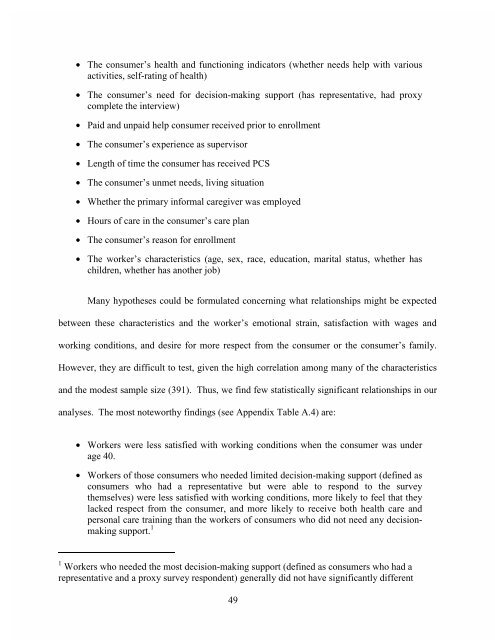The Experiences of Workers Hired Under Consumer Direction in ...
The Experiences of Workers Hired Under Consumer Direction in ...
The Experiences of Workers Hired Under Consumer Direction in ...
Create successful ePaper yourself
Turn your PDF publications into a flip-book with our unique Google optimized e-Paper software.
• <strong>The</strong> consumer’s health and function<strong>in</strong>g <strong>in</strong>dicators (whether needs help with variousactivities, self-rat<strong>in</strong>g <strong>of</strong> health)• <strong>The</strong> consumer’s need for decision-mak<strong>in</strong>g support (has representative, had proxycomplete the <strong>in</strong>terview)• Paid and unpaid help consumer received prior to enrollment• <strong>The</strong> consumer’s experience as supervisor• Length <strong>of</strong> time the consumer has received PCS• <strong>The</strong> consumer’s unmet needs, liv<strong>in</strong>g situation• Whether the primary <strong>in</strong>formal caregiver was employed• Hours <strong>of</strong> care <strong>in</strong> the consumer’s care plan• <strong>The</strong> consumer’s reason for enrollment• <strong>The</strong> worker’s characteristics (age, sex, race, education, marital status, whether haschildren, whether has another job)Many hypotheses could be formulated concern<strong>in</strong>g what relationships might be expectedbetween these characteristics and the worker’s emotional stra<strong>in</strong>, satisfaction with wages andwork<strong>in</strong>g conditions, and desire for more respect from the consumer or the consumer’s family.However, they are difficult to test, given the high correlation among many <strong>of</strong> the characteristicsand the modest sample size (391). Thus, we f<strong>in</strong>d few statistically significant relationships <strong>in</strong> ouranalyses. <strong>The</strong> most noteworthy f<strong>in</strong>d<strong>in</strong>gs (see Appendix Table A.4) are:• <strong>Workers</strong> were less satisfied with work<strong>in</strong>g conditions when the consumer was underage 40.• <strong>Workers</strong> <strong>of</strong> those consumers who needed limited decision-mak<strong>in</strong>g support (def<strong>in</strong>ed asconsumers who had a representative but were able to respond to the surveythemselves) were less satisfied with work<strong>in</strong>g conditions, more likely to feel that theylacked respect from the consumer, and more likely to receive both health care andpersonal care tra<strong>in</strong><strong>in</strong>g than the workers <strong>of</strong> consumers who did not need any decisionmak<strong>in</strong>gsupport. 11 <strong>Workers</strong> who needed the most decision-mak<strong>in</strong>g support (def<strong>in</strong>ed as consumers who had arepresentative and a proxy survey respondent) generally did not have significantly different49
















